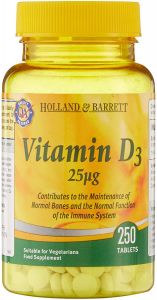Vitamin D
Vitamin D is a fat-soluble vitamin that belongs to the vitamin D family, which also includes vitamins D1, D2, and D3.
When you are directly exposed to sunlight, your body naturally produces vitamin D. To ensure adequate levels of vitamin D in your blood, you can also get it from certain foods and supplements.

Vitamin D
Vitamin D is a fat-soluble vitamin that belongs to the vitamin D family, which also includes vitamins D1, D2, and D3.
When you are directly exposed to sunlight, your body naturally produces vitamin D. To ensure adequate levels of vitamin D in your blood, you can also get it from certain foods and supplements.
Overview
Vitamin D serves several functions. Perhaps the most important are calcium and phosphorus absorption regulation and normal immune system function.
D Vitamin comes in several forms, including ergocalciferol (vitamin D2) and cholecalciferol (vitamin D3). Fish, eggs, and fortified milk all contain D vitamins. When exposed to sunlight, it is also produced in the skin. D Vitamin is stored in fat during periods of sunlight and then released when sunlight is not available.
Supplemental D vitamin is commonly used to treat and prevent vitamin D deficiency. People who do not get enough sun, as well as those aged 65 and up, are at risk of deficiency. D Vitamin is also used to treat weak and brittle bones, heart disease, asthma, hay fever, and a variety of other conditions, but there is little scientific evidence to back up many of these claims. In addition, there is no strong evidence to support the use of vitamin D supplements for COVID-19. However, it is critical to maintain adequate D vitamin levels. This can be accomplished by taking 400-1000 IU of D vitamin per day or spending 15-30 minutes per day in the sun.
Source
Some foods naturally contain vitamin D, while others are fortified with it. D Vitamin can be found in the following foods:
- Salmon
- Sardines
- Herring
- Canned tuna
- Cod liver oil
- Beef liver
- Red meat
- Egg yolk
- Shrimp
- Regular mushrooms and those treated with ultraviolet light
- Milk (fortified)
- Certain cereals and oatmeals (fortified)
- Yoghurt (fortified)
- Orange juice (fortified)
- fortified foods – such as some fat spreads and breakfast cereals
Uses & effectiveness
Vitamin D serves a variety of purposes.
These are some of them:
- A rare, inherited bone disorder characterised by low blood phosphate levels (familial hypophosphatemia). Taking calcitriol or dihydrotachysterol by mouth, along with phosphate supplements, is effective for treating bone disorders in people with low phosphate levels in the blood.
- Parathyroid dysfunction (hypoparathyroidism). Taking dihydrotachysterol, calcitriol, or ergocalciferol by mouth is effective for increasing calcium blood levels in people with low parathyroid hormone levels.
- Bone deterioration (osteomalacia). This condition can be effectively treated by taking vitamin D3 orally.
- A bone disorder that affects people who have kidney disease (renal osteodystrophy). In people with kidney failure, taking calcitriol, a specific form of vitamin D, by mouth helps to manage low calcium levels and prevent bone loss.
- Rickets. Rickets can be prevented and treated by taking the D vitamin orally. In people with kidney failure, calcitriol, a type of vitamin D, should be used.
- Deficiency of vitamin D. Vitamin D supplementation is effective for preventing and treating vitamin D deficiency.
- People who take corticosteroid drugs experience bone loss. In people taking corticosteroid drugs, taking vitamin D by mouth prevents bone loss. In addition, taking vitamin D alone or in combination with calcium appears to improve bone density in people who have already experienced bone loss as a result of corticosteroid use.
- Bones that are weak and brittle (osteoporosis). Taking vitamin D3 orally along with calcium appears to help prevent bone loss and fractures in osteoporosis patients.
- Psoriasis. Plaque-type psoriasis can be treated by applying D vitamin to the skin in the form of calcitriol, calcipotriene, maxacalcitol, or paricalcitol. Combining D vitamin and corticosteroids appear to be more effective than either vitamin D or corticosteroids alone. However, taking vitamin D orally does not appear to help.
- Cavities. In infants, children, and adolescents, taking vitamin D2 or D3 by mouth reduces the risk of cavities by 36% to 49%.
- Failure of the heart. In some people, taking the D vitamin by mouth can help reduce their risk of developing heart failure. However, it does not appear to benefit patients who already have heart failure.
- Bone loss in patients with hyperactive parathyroid (hyperparathyroidism-related bone loss). In people with hyperparathyroidism, taking vitamin D3 by mouth appears to reduce parathyroid hormone levels and bone loss.
Despite the lack of scientific evidence, It is also possible that Vitamin D could help with the following conditions:
- Coronary artery disease. People with low D vitamin levels in their blood appear to have a higher risk of developing heart disease. In most people, however, taking a vitamin D supplement does not appear to prevent heart disease, heart attack, stroke, or other serious heart-related events.
- Illness that is critical (trauma). Giving vitamin D to people who have low vitamin D levels and are in the hospital with a critical illness does not increase their chances of survival.
- Fractures. Oral vitamin D supplementation does not appear to prevent fractures in older people who do not have osteoporosis.
- Blood pressure is too high. Most people with high blood pressure do not appear to benefit from taking the D vitamin orally. However, it may benefit people who have extremely low vitamin D levels in their blood.
- Cancer of the prostate. Taking D vitamin orally does not appear to slow cancer progression or death from prostate cancer.
- Tuberculosis. Taking vitamin D orally has no effect on curing or lessening the severity of tuberculosis.
There is some interest in using the D vitamin for a variety of other purposes, but there isn’t enough reliable data to say whether it’s beneficial.
Side Effects
High doses of vitamin D taken orally can be toxic. According to research, the tolerable upper limit for adults is 100 mcg (4,000 IU) per day.
The following are some symptoms of D vitamin toxicity:
- Anorexia
- Losing weight
- Urinating frequently
- Arrhythmias of the heart
It is important to note that D vitamin toxicity is usually caused by supplementation. Spending a lot of time in the sun does not cause vitamin D toxicity, and getting too much vitamin D from food is unlikely.
D Vitamin supplements may also interact with certain medications, such as steroids, weight-loss drugs, and cholesterol-lowering medications. As a result, before beginning a new supplement, a person should always consult with a doctor.
If you get any side effects, talk to your doctor, pharmacist or nurse. This includes any possible side effects not listed on this page. In the UK you can also report side effects directly to the Yellow Card Scheme By reporting side effects you can help provide vital information on the safety of this medical supplement.
Is this medicine suitable for you?
Take precautions:
- Pregnant and breastfeeding. When used in daily amounts less than 4000 IU, D vitamin is most likely safe during pregnancy and breastfeeding (100 mcg). Do not exceed the recommended dose unless directed to do so by your doctor. When taken in higher doses during pregnancy or while breastfeeding, the D vitamin may be harmful. Higher doses may be harmful to the infant.
- Adults and children over the age of four should follow this advice. During the autumn and winter months, you must obtain vitamin D from your diet because the sun is not strong enough to produce D vitamin in the body. However, because it is difficult to get enough vitamin D from food alone, everyone (including pregnant and breastfeeding women) should consider taking a daily D vitamin supplement containing 10 micrograms of vitamin D during the autumn and winter. Between late March/early April and the end of September, most people can get all of their D vitamins from sunlight on their skin and a well-balanced diet. During these months, you may choose not to take a vitamin D supplement.
- Advice for infants and young children. The Department of Health and Social Care recommends that babies between the ages of one and one should take a daily D vitamin supplement containing 8.5 to 10 micrograms of vitamin D throughout the year if they are:
- Breastfed
- Formula-fed infants who consume less than 500ml (about a pint) of infant formula per day, because infant formula is already fortified with vitamin D
Throughout the year, children aged 1 to 4 years old should be given a daily supplement containing 10 micrograms of vitamin D. Most pharmacies and supermarkets sell vitamin D supplements or vitamin drops containing vitamin D (for children under the age of five). Women and children who qualify for the Healthy Start programme can receive free D vitamin supplements.
- Atherosclerosis (hardening of the arteries). Taking D vitamin may aggravate this condition, especially in people with kidney disease.
- Histoplasmosis is a type of fungal infection. Vitamin D may raise calcium levels in histoplasmosis patients. This could result in kidney stones and other complications. Use vitamin D with caution.
- High calcium levels in the blood. Taking vitamin D may aggravate this condition.
- Hyperparathyroidism (overactive parathyroid gland). Vitamin D may raise calcium levels in people with hyperparathyroidism. Use D vitamin with caution.
- Lymphoma. Vitamin D may raise calcium levels in lymphoma patients. This could result in kidney stones and other complications. Use vitamin D with caution.
- Kidney disease. Vitamin D may raise calcium levels and increase the risk of “artery hardening” in people with severe kidney disease. Calcium levels in people with kidney disease should be closely monitored.
- Sarcoidosis is a disease that causes swelling (inflammation) in body organs, most commonly the lungs or lymph nodes. D Vitamin may raise calcium levels in sarcoidosis patients. This could result in kidney stones and other complications. Use vitamin D with caution.
- Tuberculosis. Vitamin D may raise calcium levels in tuberculosis patients. This could result in kidney stones and other complications. Use D vitamin with caution.
Consult your doctor
If you are taking any of the following medicines please consult your doctor:
- Aluminium. Most antacids contain aluminium. Vitamin D can increase the amount of aluminium absorbed by the body. This interaction may be problematic for people who have kidney disease. Vitamin D should be taken two hours before or four hours after taking antacids.
- Calcipotriene (Dovonex). Taking calcipotriene with vitamin D may increase the effects and side effects of calcipotriene.
- Digoxin (Lanoxin). Taking D vitamin with digoxin may increase the drug’s effects and side effects. Before taking vitamin D supplements if you are taking digoxin, consult your doctor.
- Diltiazem (Cardizem, others). Calcium absorption is aided by vitamin D. Calcium can have an impact on the heart. Diltiazem can also have an effect on the heart. Taking large amounts of vitamin D with diltiazem may reduce its effectiveness.
- Verapamil (Calan, others). D Vitamin aids the body’s absorption of calcium. Calcium can have an impact on the heart. Verapamil can also have an effect on the heart. If you are taking verapamil, avoid taking large amounts of vitamin D.
- Water pills (Thiazide diuretics). Vitamin D aids the body’s absorption of calcium. Some “water pills” raise calcium levels in the body. Taking a lot of vitamin D along with some “water pills” may result in an excess of calcium in the body. This could have serious consequences, such as kidney problems.
- Atorvastatin (Lipitor). Vitamin D may reduce the amount of atorvastatin absorbed by the body. Taking vitamin D with atorvastatin may reduce its effectiveness.
- Medications altered by the liver (Cytochrome P450 3A4 (CYP 3A4) substrates). The liver changes and breaks down some medications. Vitamin D may affect how quickly the liver degrades these medications. This could have an impact on the effectiveness and side effects of these medications.
If a person notices any of the following symptoms, they should consult a doctor because they could indicate a vitamin D deficiency:
- Bone ache
- Muscle weakness
- Fatigue
- Frequent colds and infections
- Fractures
- Depression
- Slow wound healing
If a person develops new or worsening symptoms after taking a vitamin D supplement, they should discontinue use and consult a doctor immediately.
Dosage
The amount of D vitamin required for optimal functioning has been debated. According to recent research, we require more vitamin D than previously thought.
Some of the major debates surrounding D vitamin include:
- Methods for measuring D vitamin levels should be standardised. the distinction between free D vitamin testing and total vitamin D testing.
- Defining D vitamin deficiency (insufficiency versus deficiency).
- Choosing between screening and treatment
- The general population’s vitamin D threshold in relation to a specific condition (such as pregnancy or breastfeeding) and health issues (such as kidney failure or osteoporosis)
The acceptable range for blood serum levels is 50–100 nanomoles per litre (nmol/L). You may require more vitamin D depending on your blood level. From late March/early April to the end of September, most people should be able to get all of their vitamin D from sunlight on their skin.
Children as young as one year old, as well as adults, require 10 micrograms of D vitamin per day. Pregnant and breastfeeding women, as well as people at risk of vitamin D deficiency, are included.
Babies up to one year of age require 8.5 to 10 micrograms of vitamin D per day.
A microgram is 1,000 times the size of a milligramme (mg). The Greek symbol μ followed by the letter g ( μg) is sometimes used to represent the word microgram.
The amount of D vitamin is sometimes expressed in International Units (IU). One microgram of vitamin D equals 40 IU. As a result, 10 micrograms of vitamin D equals 400 IU.
Other names
- Lanolin comes from sheep’s wool.
- Fish oils, such as cod liver oil.
- Algae oil, which is suitable for vegans.



